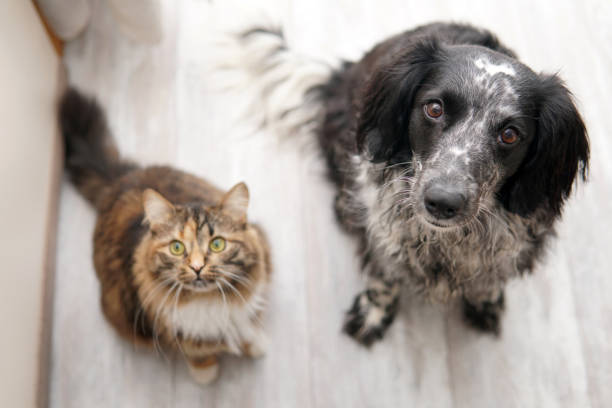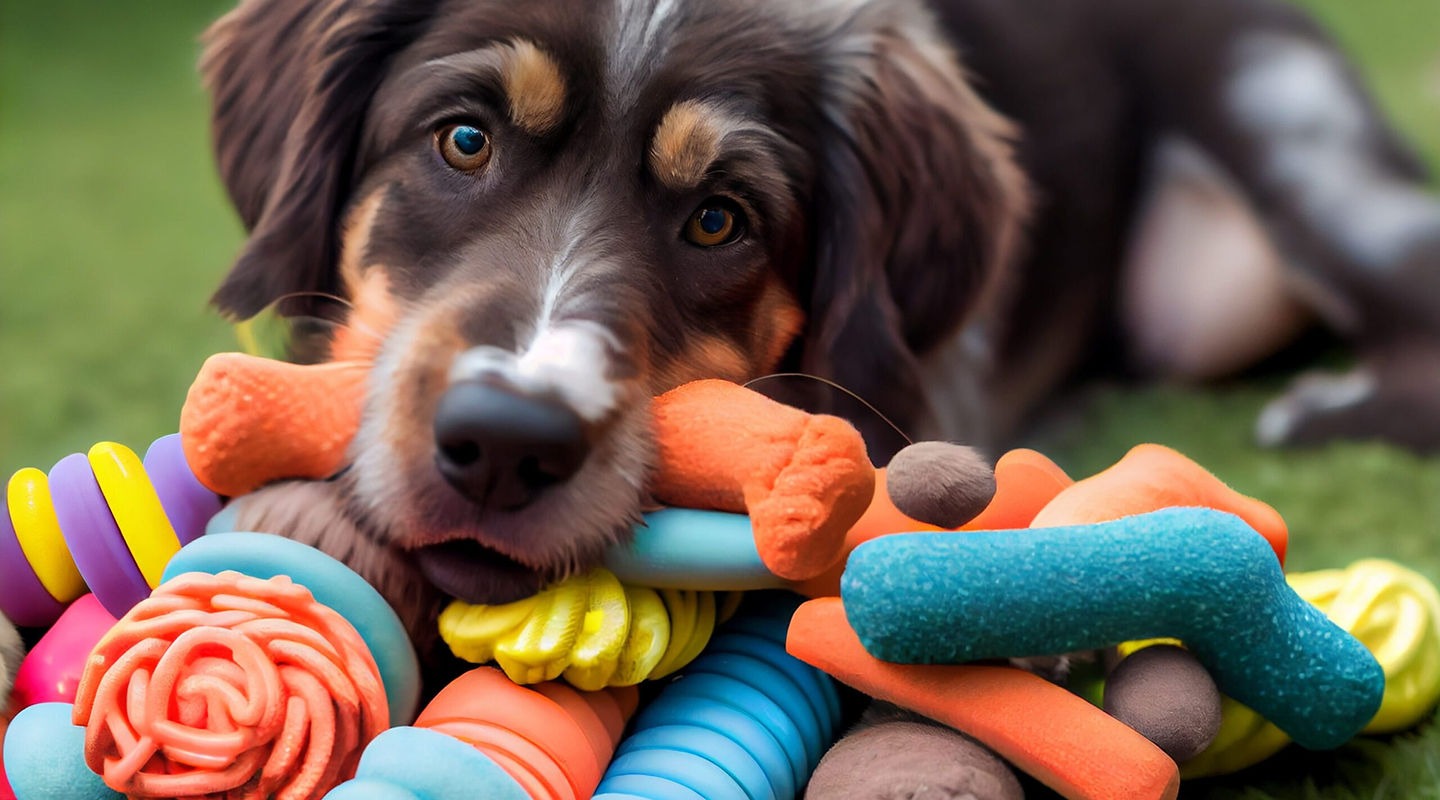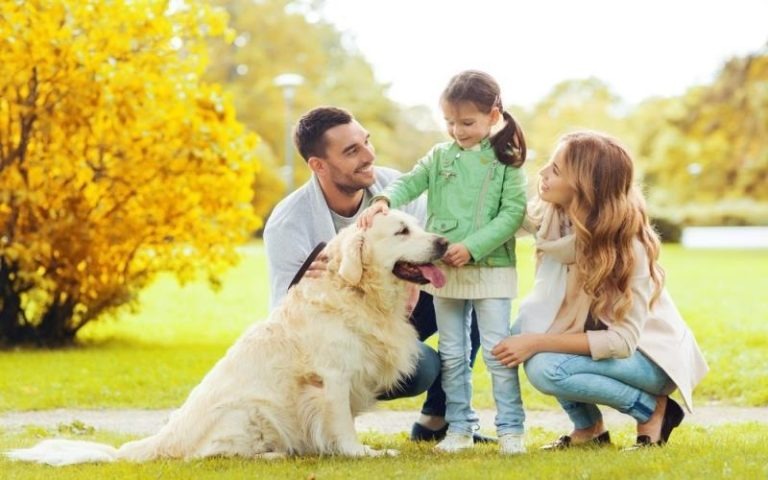
Why Some Dog and Cat Breeds Are More Prone to Anxiety: Unraveling the Genetic and Environmental Factors Behind Pet Anxiety
Anxiety in pets is a growing concern, with certain dog and cat breeds being more susceptible. This article explores the genetic, environmental, and behavioral factors contributing to pet anxiety and offers practical solutions.
🐶 Pet Star
45 min read · 13, Mar 2025

Introduction: Understanding Pet Anxiety
Anxiety in pets is a widely discussed issue among veterinarians, pet owners, and animal behaviorists. Just like humans, dogs and cats can experience anxiety, which can manifest in various forms, from excessive barking and destructive chewing to urinating in the house or hiding. For some pets, anxiety is a temporary phase, but for others, it becomes a long-term challenge that can significantly affect their quality of life.
Pet anxiety often goes unnoticed or misinterpreted as bad behavior, but it can be deeply distressing for animals. More importantly, certain dog and cat breeds are more predisposed to developing anxiety, which raises an important question: why are some breeds more susceptible to this condition than others?
This article dives deep into the genetic and environmental factors that influence anxiety in pets, focusing on specific dog and cat breeds known to be more prone to these issues. By understanding these factors, pet owners and veterinarians can better manage and treat anxiety, leading to healthier and happier pets.
The Genetics of Anxiety: How Breed Plays a Role
Genetic Predispositions and Behavioral Traits
The genetic makeup of an animal plays a substantial role in determining its behavior, including its susceptibility to anxiety. Similar to how certain human conditions, like anxiety or depression, can run in families, the genetic predisposition to anxiety in pets may be inherited from their parents. While specific genes responsible for anxiety in pets are not yet fully identified, studies have shown that some breeds are more likely to exhibit anxious behavior due to their genetic predispositions.
Certain breeds, especially those bred for guarding, herding, or companionship, may have traits that make them more sensitive to changes in their environment or routine. For example, breeds with high intelligence and sensitivity—like Border Collies or Shetland Sheepdogs—are more prone to anxiety because their brains process information quickly, and they are more reactive to external stimuli.
Breeds that were originally bred to work alongside humans or in specific roles often have highly attuned nervous systems. When they are not properly stimulated or their routine is disrupted, it can lead to stress and anxiety. These breeds often require more mental and physical stimulation to maintain their balance and well-being.
Hyper-Attachment and Separation Anxiety
Another genetic factor influencing anxiety in certain breeds is the tendency toward hyper-attachment. Dogs that are genetically predisposed to forming strong bonds with their owners may experience separation anxiety when left alone. Breeds like Dachshunds, Cavalier King Charles Spaniels, and Bichon Frises are more likely to develop this condition due to their strong attachment to their human family members. These breeds can become excessively anxious when separated from their owners, leading to destructive behavior, excessive barking, and even self-harm in severe cases.
In cats, certain breeds also show attachment-related anxiety. For instance, the Siamese cat is often known to be particularly clingy and prone to anxiety when left alone for long periods.
The Role of Environmental Factors in Pet Anxiety
The Impact of Early Life Experiences
Beyond genetics, a pet's early life experiences can have a profound impact on their emotional health. If a pet's formative weeks are spent in an environment that is stressful, traumatic, or inconsistent, it can set the stage for anxiety-related behaviors later in life. For example, puppies or kittens raised in overcrowded or chaotic conditions may struggle with anxiety as they grow older.
For many pets, especially those with a nervous disposition, exposure to positive socialization experiences during their early months can greatly reduce the likelihood of developing anxiety later on. Early exposure to new environments, people, and other animals can help prevent the development of fear-based behaviors and increase a pet’s resilience to stress.
Conversely, if a young animal experiences neglect, abuse, or lack of proper care, it may develop a fear response that persists throughout its life. This is particularly true for breeds that are more sensitive to environmental cues.
Changes in Routine and Environment
Dogs and cats are creatures of habit, and sudden changes in their environment or routine can trigger anxiety. For pets that are already predisposed to anxiety, any disruption can become overwhelming. For example, moving to a new home, introducing a new pet into the household, or even the loss of a family member can cause significant stress for pets that are already prone to anxiety.
While some pets are more adaptable to change, breeds that have a strong need for consistency in their environment, such as Greyhounds and German Shepherds, may experience heightened anxiety when faced with disruptions.
Common Dog Breeds Prone to Anxiety
Border Collies
Known for their intelligence and high energy, Border Collies are often praised as one of the most trainable dog breeds. However, this same intelligence can make them more susceptible to anxiety. Their high energy levels require ample physical and mental stimulation, and without it, they may resort to destructive behaviors such as chewing, digging, or excessive barking. Border Collies are also prone to separation anxiety due to their strong bond with their owners.
Cavalier King Charles Spaniel
This affectionate and loving breed is often described as a "velcro dog" due to their desire to stay close to their human family members. While their loving nature makes them excellent companions, it also makes them prone to separation anxiety. When left alone, Cavalier King Charles Spaniels can become distressed, resulting in destructive behavior or excessive vocalization.
Chihuahuas
Although small in size, Chihuahuas are known for their large personalities. Their strong bond with their owners and their heightened sensitivity to changes in their environment make them particularly vulnerable to anxiety. Chihuahuas may exhibit fear-based behaviors when faced with unfamiliar situations or people, often leading to nervousness and aggression.
German Shepherds
As a working breed, German Shepherds are highly intelligent and eager to please. However, their strong desire for structure and purpose means that any disruption to their routine or environment can cause anxiety. German Shepherds are particularly prone to separation anxiety, as they form strong attachments to their families.
Common Cat Breeds Prone to Anxiety
Siamese Cats
Siamese cats are known for their vocal, attention-seeking behavior and strong attachment to their owners. Due to their social nature, they often suffer from anxiety when left alone for extended periods. They are more likely to develop separation anxiety, and in some cases, may exhibit destructive behaviors when feeling stressed.
Maine Coon Cats
While Maine Coon cats are generally known for their laid-back and friendly demeanor, they can also develop anxiety, particularly if there are major changes in their environment. They are highly social and thrive in stable, consistent settings. Disruptions, such as a move or changes in the family dynamic, can cause them stress and anxiety.
Managing Anxiety in Prone Breeds: Practical Solutions
Proper Exercise and Mental Stimulation
For breeds prone to anxiety, regular exercise and mental stimulation are crucial. Engaging in activities that challenge a pet mentally—such as puzzle toys, training sessions, and interactive games—can help release pent-up energy and reduce stress. Additionally, providing sufficient physical exercise can tire out an anxious pet and promote relaxation.
Consistency and Predictability
Creating a consistent daily routine can greatly reduce anxiety in pets. Predictability in meal times, walks, and play sessions can help establish a sense of security. This is especially beneficial for breeds that are sensitive to changes in their environment.
Behavioral Therapy and Training
Behavioral therapy, including positive reinforcement training, can help pets with anxiety learn to manage their fear responses. For dogs and cats with separation anxiety, desensitization and counter-conditioning techniques can help them feel more comfortable being left alone. For example, gradually increasing the amount of time a pet spends alone, while pairing the experience with positive reinforcement (such as treats or toys), can reduce anxiety over time.
Calming Products and Medications
For pets with severe anxiety, calming products such as pheromone diffusers, anxiety wraps, or calming supplements may provide relief. In some cases, veterinarians may recommend anti-anxiety medications, particularly for breeds with a strong genetic predisposition to anxiety disorders.
The Future of Pet Anxiety: Advancements in Understanding and Treatment
As the understanding of pet anxiety evolves, new strategies and techniques are being developed to help pets cope with their anxiety in healthier, more sustainable ways. Researchers and veterinarians are continuing to explore the complex interplay of genetic, environmental, and behavioral factors that contribute to anxiety in pets, and their findings are influencing both breeding practices and treatment options.
Genetic Research and Selective Breeding
One of the most promising areas of research in the future of pet anxiety is the role of genetic research. As more is understood about the genetic predispositions that make certain dog and cat breeds more prone to anxiety, breeders may be able to select animals that are less likely to inherit anxiety-related traits. This could lead to a reduction in the overall prevalence of anxiety in certain breeds.
However, genetic research alone is not a quick fix for the problem. Ethical breeding practices, which prioritize the health and well-being of pets rather than focusing solely on physical traits or appearance, will need to be implemented alongside genetic research. In the future, breeders will be more likely to work with genetic counselors and veterinarians to ensure that puppies and kittens are born with the best chances of being emotionally balanced.
Advances in Behavioral Therapy and Training Techniques
Another exciting development in managing pet anxiety is the expansion of behavioral therapy and training techniques. Behavioral science has come a long way in understanding how pets process fear and anxiety, and new methods are being developed to help them cope. For example, more pet owners are turning to desensitization techniques, which gradually expose pets to situations that trigger their anxiety in a controlled way, allowing them to become less sensitive to these triggers over time.
Furthermore, with the growing popularity of positive reinforcement methods, there is less reliance on aversive training techniques that could exacerbate anxiety in pets. New training methods focused on building trust, calmness, and confidence in pets are helping alleviate anxiety by teaching them how to respond to triggers in healthier ways.
Technological Solutions for Pet Anxiety
In addition to behavioral therapy, technology is playing an increasingly important role in the treatment of pet anxiety. Products like calming collars, pheromone diffusers, and wearable devices that monitor pets' anxiety levels are becoming more widely available. These products aim to reduce stress through methods such as releasing calming scents or providing physical comfort (e.g., anxiety wraps that apply gentle pressure to help soothe the pet).
Moreover, telemedicine is emerging as a convenient tool for pet owners seeking professional help for anxiety-related issues. Online consultations with veterinarians or animal behaviorists can provide timely and cost-effective solutions, enabling pet owners to address anxiety issues without needing to make a trip to the clinic.
Holistic and Natural Approaches
Alongside medical and behavioral treatments, many pet owners are seeking more natural or holistic solutions to manage anxiety in pets. Herbal remedies, acupuncture, and massage therapy have gained popularity as alternatives or complementary treatments for anxiety. Natural supplements such as valerian root, L-theanine, and CBD oil have been studied for their potential to help calm anxious pets.
While research into the effectiveness of these treatments is still ongoing, there is evidence to suggest that they can provide support for pets with mild to moderate anxiety. As with all treatments, it is essential to consult with a veterinarian before administering any of these remedies to ensure they are safe and appropriate for the pet’s condition.
Promoting Mental Health for All Pets
Although this article has focused on specific breeds that are prone to anxiety, it’s important to note that all pets—regardless of breed—can experience anxiety. As awareness of pet anxiety grows, so too does the emphasis on overall mental well-being for pets of all types.
One of the key steps in promoting better mental health for pets is to reduce the stigma surrounding anxiety in animals. Just as we advocate for mental health care in humans, we must also acknowledge that pets, too, deserve a holistic approach to their emotional needs. This includes providing pets with the right amount of social interaction, mental stimulation, and emotional support, while avoiding situations that might provoke stress.
Creating a pet-friendly environment with plenty of enriching activities—such as puzzle feeders, interactive toys, and outdoor walks—can help prevent the onset of anxiety. Additionally, ensuring that pets have a quiet, safe space to retreat to when they feel overwhelmed can make a world of difference.
Conclusion
In conclusion, the growing understanding of why certain dog and cat breeds are more prone to anxiety has led to significant advancements in both pet care and breeding practices. As we learn more about the genetic, environmental, and behavioral factors that contribute to pet anxiety, more targeted solutions are being developed to help manage and mitigate the stress experienced by these animals. Selective breeding, combined with modern training techniques, advances in veterinary care, and the rise of technological and natural treatments, are providing better options for pet owners.
While some breeds are more predisposed to anxiety, it’s important to note that any pet, regardless of breed, can experience anxiety. Therefore, creating a pet-friendly environment with plenty of mental stimulation, enrichment, and safe spaces for relaxation is critical in preventing and managing anxiety. Understanding that pets need emotional support just as much as physical care will help foster a healthier, happier environment for pets of all breeds.
As the research into pet anxiety continues to grow, we can expect more innovations to help reduce stress for our furry friends. Pet owners should stay informed about the latest findings and solutions available to ensure they are offering the best care for their pets. Ultimately, our goal should be to foster a greater understanding and compassion for pets dealing with anxiety, leading to better health, happiness, and quality of life for all animals.
Q&A
Q: What are some common signs of anxiety in dogs and cats?
A: Common signs of anxiety include excessive barking or meowing, destructive behavior, panting or drooling, hiding, and changes in appetite or sleeping patterns. Some pets may also exhibit repetitive behaviors, like pacing.
Q: Why are certain dog and cat breeds more prone to anxiety?
A: Certain breeds have genetic predispositions to anxiety due to their temperaments and nervous systems. For example, breeds like Border Collies and Siamese cats are more sensitive, which can lead to higher anxiety levels.
Q: Can selective breeding reduce anxiety in future pets?
A: Yes, selective breeding could potentially reduce anxiety in pets by focusing on animals with more balanced temperaments. However, it’s important to prioritize health and well-being over appearance in breeding practices.
Q: What training methods can help reduce anxiety in pets?
A: Positive reinforcement training, desensitization, and counter-conditioning can be effective in reducing anxiety. These methods involve gradually exposing pets to anxiety triggers in a controlled way to help them become less sensitive over time.
Q: How do environmental factors contribute to anxiety in pets?
A: Environmental factors such as noise, lack of stimulation, and a stressful home environment can contribute to anxiety in pets. It’s essential to create a safe, quiet space where pets can retreat and feel secure.
Q: Can diet play a role in managing pet anxiety?
A: Yes, certain nutrients, like omega-3 fatty acids, can support brain health and help reduce anxiety. Some pet owners also use calming supplements that include ingredients like L-theanine, valerian root, or CBD oil.
Q: How can technology help pets with anxiety?
A: Technological products such as pheromone diffusers, calming collars, and wearable devices that monitor stress levels are being used to help reduce anxiety in pets. These solutions are designed to provide calming stimuli or track anxiety patterns.
Q: Are there any medications available for pets with anxiety?
A: Yes, veterinarians may prescribe anti-anxiety medications, such as SSRIs or benzodiazepines, for pets with severe anxiety. However, medication is usually combined with behavioral therapy for the best results.
Q: Can anxiety in pets be fully cured?
A: While anxiety may not always be fully "cured," it can be managed effectively with a combination of behavioral therapy, medication (if necessary), and environmental adjustments. Each pet’s treatment plan will vary.
Q: What steps can pet owners take to prevent anxiety in pets?
A: Preventative measures include providing a stable, predictable routine, offering mental stimulation and physical exercise, ensuring adequate socialization, and using training to reinforce positive behaviors. Additionally, reducing stressors in the environment can be helpful.
Similar Articles
Find more relatable content in similar Articles

Sustainable Pet Products: What to Look for in 2025...
As sustainability becomes a ce.. Read More

Vegan Pet Toys and Accessories That Last Longer...
As pet owners grow more eco-co.. Read More

How Pets Strengthen Family Bonds...
Pets are more than just compan.. Read More

How Climate Change Affects Wild and Domestic Animals...
Climate change is dramatically.. Read More
Explore Other Categories
© 2024 Copyrights by rPets. All Rights Reserved.